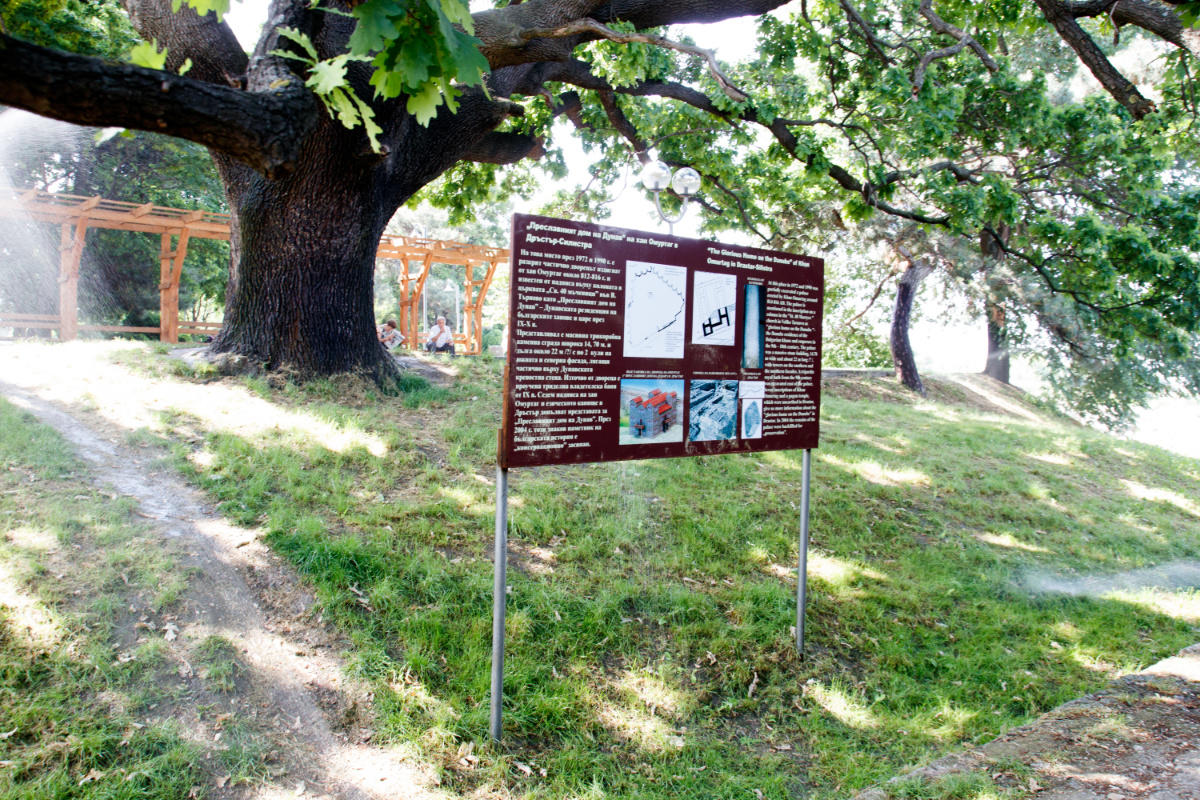The Khan Omurtag Palace House of the Danube
Category CastleLOCATION
Khan Omurtag’s Palace House of the Danube is located on the bank of the Danube, in the Danube Park in the town of Silistra, Silistra Municipality and 429 km away from the capital Sofia. There is a bus three times a day leaving from the Sofia Central Bus Station to Silistra, as well as a train three times a day from the Sofia Central Railway Station.
DESCRIPTION
The palace of Khan Omurtag was a royal residence until the end of the 10th century. At the same time it was used as a defensive fortress against the Magyar invasions. The palace was partially discovered in 1972 and 1988 on the banks of the Danube, partially overlooking the northern fortress wall of the citadel, which reaches 4.20 in this area. The building has a representative character.
HISTORY
The palace of Khan Omurtag is also called the "Danube Residence of the Bulgarian Khans". Its existence has been known for a long time before it was actually discovered thanks to the famous inscription of Omurtag on the column located in the church "St. Forty Martyrs" in Veliko Tarnovo. It is translated by the famous Bulgarian scientist Veselin Beseliev, but the description of the location is not clear enough.
The palace was searched for nearly a century. For about 40 years it was believed that the palace is located in the Romanian island Păcuiul lui Soare, located 20 km away from Silistra. At the end of the 1960s archaeologist Stefka Angelova from the Sofia University "St. Kliment Ohridski "was close to the discovery, but the authorities did not allow it to continue because it was necessary to cut down the century-old oak tree near the Danube River in Silistra.[1]
The hypothesis that the palace is located beneath the century old oak was proven to be true in 1972. The discoverer is Prof. Dr. Georgi Atanasov. A testimony that this is the palace of Khan Omurtag is the inscription on a column totally identical to that of the "St Forty Martyrs". It reads: "Yuvigi khan Omurtag", written in Greek letters (kanas yovigi Omurtag).
It is believed that the inscription was placed in the first years of Omurtag’s rule by the construction manager himself, one of the strategists (former Byzantine generals) coming from the Eastern provinces of Byzantium, connected with pavlikianism and monophysitism, who were allowed to join Bulgarian service and keep their titles under Khan Krum’s reign. They were removed from by Omurtag after 816. This shows that the reconstruction of the Drustur fortress and the construction of the palace of Khan Omurtag took place in the last years of Krum's rule and was completed in the early years of his son Omurtag.
The palace itself features plenty inscriptions and columns that support Professor Atanassov's hypothesis that its architecture replicates the palace in Pliska. The overall plan of the village resembles that of the first Bulgarian capital, but it is even better fortified. This is evidenced by the remnants of 14-meter-thick walls, reinforced with densely positioned towers, which suggest that attackers are cross-shot. A pagan temple was discovered within the site, the second largest after the temple in Pliska. The palace of Khan Omurtag was a Khan and royal residence until the end of the 10th century. In 896 - 897, King Simeon the Great himself settled there. At the same time it was used as a defensive fortress against the Magyar invasions.[2]
Excavations have also revealed miniature silver icons with images of archangels who hold symbols of the royal power. Apart from the ruler's home, the place was also an important military stronghold, which retained its significance after the fall of Bulgaria under Byzantine rule. It is believed to have been destroyed by the invasion of the uzes and the pechenegs.[3]
In 927 Drastar was declared the residence of the Bulgarian patriarchs. Between 969 and 971, Drastar became the arena of important military-political events related to the war between Bulgaria, Kievan Russia and Byzantium. In the years of Byzantine domination, XI-XII century, the city was declared a political and religious center of Northern Bulgaria. With the rebuilding of the Bulgarian state by the Assenevtsi dynasty in 1185-1188, the settlement on the bank of the Danube become once more one of the prosperous state centers, the seat of the Metropolitan. At the end of the fourteenth century, in an extended period of division and struggle for power, Drastar was turned into a center of an independent feudal principality run by the despot Ioan Terter, who cut silver and copper coins there.[4]
At the Third International Congress on Bulgarian Studies, held at the Sofia University in Sofia, in 2012 Prof. Dr. G. Atanassov presented a report on "New data on the palace of Khan Omurtag in Drustar (Silistra)." New arguments for the localization of the Danube Presidential House in Drustar / Silistra are presented. Thanks to the original archive of the museum's original plans and photographs from 1970-1971, the complete reconstruction of the Palace's plan and its approximate three-dimensional reconstruction became possible.[5]
SITE SIGNIFICANCE
The palace of Khan Omurtag was a khan and royal residence until the end of the 10th century.
VISITOR INFORMATION
The place where the remains of the palace was discovered is located outside and it is free to visit.
There is a large information plate in Bulgarian and English with photographs and plans of the monument.
SITE CLASSIFICATION
Historical site
[1] Portal-silistra.eu. <http://www.portal-silistra.eu/news/1865> (03.04.2018)
[2] Actualno.com. <https://www.actualno.com/chronicles/prof-g-atanasov-za-actualnocom-ochakvam-sydejstvie-za-razkrivane-i-konservirane-na-dvoreca-na-han-omurtag-news_409098.html> (24.04.2018)
[3] Spisanie8.bg. <https://www.spisanie8.bg/%D0%BD%D0%BE%D0%B2%D0%B8%D0%BD%D0%B8/%D0%B8%D1%81%D1%82%D0%BE%D1%80%D0%B8%D1%8F/1485-%D0%BE%D1%82%D0%BA%D1%80%D0%B8%D1%85%D0%B0-%D0%B4%D0%B2%D0%BE%D1%80%D0%B5%D1%86%D0%B0-%D0%BD%D0%B0-%D0%BE%D0%BC%D1%83%D1%80%D1%82%D0%B0%D0%B3.html> (24.04.2018)
[4] <http://www.nasamnatam.com/patepis/Durostorum_Drystyr_tvyrdina_na_brega_na_Dunava-989.html> (24.04.2017)
[5] Museumsilistra.com. <http://www.museumsilistra.com/index.php/novini/65-prof-d-i-n-g-atanasov-predstavi-doklad-na-tema-novi-danni-za-dvoretza-na-han-omurtag-v-drastar> (24.04.2018)




